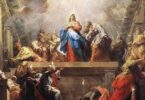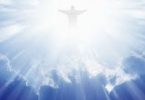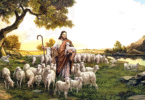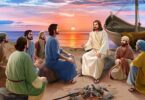18th Sunday of Ordinary Time (Year B)
Scripture: Ex. 16:2-4, 12-15; Ps. 78:3,4, 23-24, 25, 54; Eph. 4:17, 20-24; Jn. 6:24-35
Last Sunday, we heard about the feeding of the five thousand men. This was one of the seven signs recorded in the Gospel of John. Jesus fed them from five loaves and two fish. The disciples collected twelve baskets of leftovers. After having seen the miracle, the people recognized Jesus as the great prophet who was to come. The Gospel text ends with the people trying to make Jesus the king. But Jesus withdrew again to the mountain by himself.
St. John the evangelist tells us in his Gospel after the miraculous feeding, the disciples and Jesus travelled across the lake and reached Capernaum, a village where Jesus spent maximum time in his ministry. The Gospel of today begins with people searching for Jesus. They followed him up to Capernaum. However, Jesus had known their real motives for following and questioned them. He knew that they had their fill and they were seeking only bread to live on. Jesus uses this occasion to reveal the most beautiful secret of his life.
Jesus makes a unique claim of himself i.e. I am the Bread of Life. What does it mean? Studies show us that bread is one of the greatest symbolism in the bible. There are more than 492 times references to bread in the entire bible. While referring to these verses in the bible, we begin to realize that each of these references reveals to us God’s real nature. We shall concentrate on a few of them to grasp the claim of Jesus being the bread of life.
The book of Exodus (first reading) reveals to us that is God provides. When the people of Israel were returning to the promised land, they were in need of food. They grumbled at God and his messenger Moses. God did not angrily respond to their bad behaviour but he chose to show his love. He lavished on them heavenly food “Manna”. It shows that the ultimate sustenance came from God alone. It occurred continuously for forty years in their wandering.
The Israelites have yet another practice related to bread. When they fled from Egypt, Moses told them to prepare unleavened bread as a mark of haste. In the bible, leaven is the symbol of sin. Like leaven that permeates the whole dough, sin spreads in a person and puts him in the clutches of slavery (Gal. 5:9). The unleavened bread became the symbol of God’s salvation from the slavery of Egyptians. It made them realized that God is life and salvation.
The Jews also had rich symbolism of bread which they kept in the Temple. Moses had instructed them to keep twelve loaves representing the twelve tribes of Israel. (Ex 25:30). The table was on the north side of the temple and the showbread was a perpetual reminder of God’s generosity and the channel of abundance and prosperity. This bread was set before the Lord regularly as a lasting covenant. They were replaced on every Sabbath. This bread symbolized the eternal presence of God. The Talmud tells, “If a person wants to become rich, he should point his feet to the north when he prays.” (ava Basra 25a.)
These symbolic celebrations in the Jewish culture enlighten our minds to see Jesus as the fulfilment of God’s promise to the people of Israel. Jesus is seen to be the bread coming down from heaven right from his very birth. Jesus was born in Bethlehem which means (Beth+lehem) house of bread. Jesus was put in the manger which was meant to put fodder for the animal. It shows that Jesus became the food for us from the time of his birth.
Jesus during the course of his ministry invited his disciples to look at him as the bread of life. He emphasized that he is the nourishment, the food that we need in our earthly pilgrimage. Adam and Eve, our first parents were told to earn their food from the sweat of their brow until they return to the ground (Gen. 3:18-19). God reversed his creation when he sent his son on earth. He worked for us and became the food for us.
Jesus offers his body and blood as food for our nourishment in the Sacrament of the Eucharist. The words of consecration, “TAKE THIS, ALL OF YOU, AND EAT OF IT, FOR THIS IS MY BODY, WHICH WILL BE GIVEN UP FOR YOU” remind us that Jesus has become the food for our sustenance, salvation and his abiding presence. He is the fulfilment of the Old Testament symbolism of bread. He has become the ultimate sustenance for us to live on earth just like the manna in the wilderness. He becomes the life and salvation just like the unleavened bread on the day of Passover. He has become the bread of presence to show his eternal presence in our midst.
The people of the Old Testament only ate manna but today God gives his body to us for our nourishment. How much more grateful we should be for the gift of Jesus who comes into our lives in the form of bread? All Glory be to the Father and the Son and the Holy Spirit!






